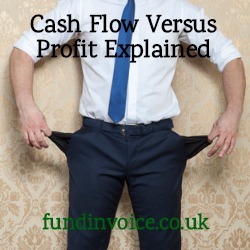- 17 Jun
Cash Flow Versus Profit.
 Cash flow is not the same thing as profit. Whilst profitability is a measure of how successfully a business can sell its products or services, at a margin over and above its expenses, cash flow is the measure of how smoothly the cash from those sales flows through the business.
Cash flow is not the same thing as profit. Whilst profitability is a measure of how successfully a business can sell its products or services, at a margin over and above its expenses, cash flow is the measure of how smoothly the cash from those sales flows through the business.Cash Flow Versus Profit
Cash flow Is a measure of the ability of a business to use its assets, its current assets – those that are almost immediately available, to pay its liabilities as they fall due.
In order to make a profit, a business has to sell its products or services at a margin over and above its costs. If its costs exceed its income, it is a loss-making business. Conversely, if income exceeds costs, it is profitable.
Profitability And Good Cash Flow Are Different
However, the fact that a business is profitable does not necessarily guarantee that it will have a strong cash flow, putting it in a position to be able to pay its creditors.
The cash flow of a business is a measure of how easily it is able to settle its liabilities as they fall due. This requires an inflow of cash from sales to be readily available. Even a business that is loss-making, could be in a position of being cash-rich at a given time. This is because the business could be at a point in its trading cycle where is income has been received but perhaps expenses have not yet been fully dispersed. Therefore, the company is in a cash-rich position and currently has a good cash flow.
Conversely, if a company is trading at a profit, but they have not been paid for goods that have been sold, they could be in a negative cash position, whereby they are unable to settle the liabilities because they have not yet received payment for the goods and services supplied - the proceeds of the sale.
A Profitable Business With Poor Cash Flow
This is an example of how you can have a profitable business, with poor cash flow.
A business may be able to make a profit "on paper" i.e. it has sold a product or service at a margin over and above the cost of the sale and expenses. As an example, if a business sells a product for £1,000 they may immediately raise an invoice, to their customer, on 30-day terms for that £1,000. If costs were £500, at this point, on paper, they have made a profit of £500 i.e. sales income minus costs and expenses.
However, the business has not yet been paid the £1,000 in respect of the goods and services supplied. In this example, the debtor has 30-day terms to pay for the supply. The supplier is profitable, yet has no cash. If they have to settle the expenses upfront, they will not have the cash to pay them - they are cash poor.
Accelerating Cash Flow
One way of remedying the position of a company that has a poor cash flow position is to use receivables financing as a means of accelerating their cash flow. This service works by providing a prepayment against the sales invoices for goods or services, at the point that the invoice is raised i.e. before the customer pays.
This pre-payment is typically for the majority of the value of the invoice, with the balance passed to the supplier, minus fees, once the customer pays.
The effect of this kind of financing is that the supplier receives the bulk of the value of their invoices immediately that they are raised, rather than having to wait for the debtor to pay. This significantly improves their cash flow position. It can enable the supplier to use that money to settle their creditors, overheads and expenses.
For help accelerating your cash flow please call Sean on 03330 113622.
- Home
- Business Financing
- Invoice Finance
- Invoice Discounting
- Factoring
- Debt Factoring
- Recourse Factoring
- Fund Selected Invoices
- Business Loans
- Construction Sector Funding
- Protect Against Bad Debts
- Exports Collection And Funding
- Import Funding
- Body Shop Funding
- Spot Factoring
- Retail Sector Funding
- Fund Invoices Confidentially
- Help Running Your Payroll
- CHOCs Customer Handles Own Collections
- Collect Invoices Confidentially And Funding
- Outsourcing Your Credit Control
- Asset Finance And Mortgages
- Case Studies
- About Us
- Testimonials
- Find Out More
- News
- Free Magazine
- Blog






